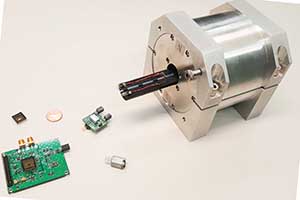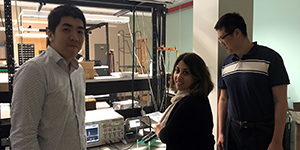The University of Macau (UM) and Harvard University have developed a portable nuclear magnetic resonance (NMR) platform by using advanced integrated circuits technology. The platform not only can significantly improve the efficiency and effectiveness of NMR tests; it can also be applied in biological diagnostic tests. For instance, conducting blood and protein tests with this platform is much cheaper and faster than using the traditional NMR testing method.
The UM researcher that worked with the research team at Harvard University is Dr Lei Ka-Meng of the Institute of Microelectronics. In 2017, Dr Lei was invited to serve as a postdoctoral visiting scholar at Harvard University for a two-year term. During his stay at Harvard University, Dr Lei carried out interdisciplinary research with faculty members of the Harvard School of Engineering and Applied Sciences and Department of Physics in an effort to improve the older version of the NMR platform to enable more effective application of the platform in different fields (such as for testing the concentration of protein, molecular structure, and the ingredients of food samples). ‘One member of the interdisciplinary research team is a scientific advisor at Schlumberger, the world’s leading oilfield service provider, and through working with him, I gained a better understanding of the merits and drawbacks of the old version of the platform and was able to improve it,’ says Dr Lei.
This portable NMR platform consists of semiconductor chips and portable magnets for NMR testing. Thanks to proposed parallelism for portable NMR which reduces experimental time, this platform can be used to perform fast testing of biological and chemical samples (such as DNA and protein samples), thereby significantly reducing the cost and time of the tests. ‘The current diagnostic tests usually require the use of large devices and a lot of time and skilled professionals, but with the proposed NMR technique, we no longer need to use large devices for diagnostic tests and the cost can be brought down from between MOP 500,000 and MOP 600,000 to between MOP 30,000 and MOP 40,000,’Dr Lei explains. ‘Moreover, this technique allows diagnostic tests to be conducted outside the centralised laboratory. Even clinics in remote regions can afford it. I really hope this technique will be introduced to other parts of the world.’
Dr Lei was born and raised in Macao. He received his bachelor’s degree in electrical and electronics engineering from UM in 2012, and he was among the first cohort to graduate from UM’s Honours College. He began to participate in challenging research projects of the State-Key Laboratory of Analog and Mixed-Signal VLSI in his third year of undergraduate studies. Because of his outstanding research capability, after receiving his bachelor’s degree he was directly admitted for PhD studies at UM, under the joint supervision of the laboratory’s deputy director Prof Mak Pui In and associate professor Law Man Kay. In 2017, he received the prestigious Predoctoral Achievement Award from the Solid-State Circuits Society of the Institute of Electrical and Electronics Engineers.
澳門大學與美國哈佛大學進行跨學科研究合作,利用先進的集成電路技術及採用平行處理實驗樣本手段,研發出可攜式的快速核磁共振實驗平台。此研發不但大大提升核磁共振實驗的操作效率,更能廣泛應用到生物檢測技術,如用在血液和蛋白質的分析檢測,並能大大降低傳統生物檢測的成本和時間。
是次與哈佛大學研究團隊合作的是澳大微電子研究院助理教授李家明,他在2017年以澳大“濠江學者"身份,應邀到哈佛大學擔任兩年的博士後訪問學者。期間,李家明與哈佛大學工程與應用科學學院和物理系團隊展開跨學科研究,從而改良原有的技術,使核磁共振平台更有效地應用在不同的領域,如檢測蛋白質濃度、分子結構、食物樣本之成份等。李家明表示,團隊其中一位成員是油田服務公司斯倫貝謝有限公司的科學顧問,從他身上能更清楚了解相關研究的長短處,從而改良研究成果。
是次研發以使用於核磁共振檢測之半導體晶片及可攜式磁石為主,並結合平行處理實驗樣本之手段,以降低檢測所需時間,可應用於生物(如DNA和蛋白質)及化學樣本的快速檢測,大大降低檢測成本及所需時間。李家明表示,市面上的核磁共振檢測儀器一般體積較為龐大,並且需要專業技術員去操作及步驟繁複,有了這項可攜式核磁共振技術後,將儀器的體積大幅縮小,成本從五、六十萬澳門元降低到三、四萬澳門元,並簡化實驗所需人力及步驟。而且不一定在大型實驗室,即使是家庭式診所也能負擔得起,希望此技術能普及至世界各地。
李家明是土生土長的澳門人。2012年自澳大獲得電機及電子工程學士學位,並成為澳大榮譽學院的首屆畢業生之一。在就讀本科三年級時,已開始參與澳大模擬與混合信號超大規模集成電路國家重點實驗室的研究。由於能力出色,畢業後直接獲錄取為博士生,其導師為該實驗室副主任麥沛然及副教授羅文基。2017年,更獲IEEE固態電路學會頒發“博士生成就獎"。

The portable NMR platform
可攜式核磁共振平台

Dr Lei with Harvard researchers
李家明與哈佛研究團

